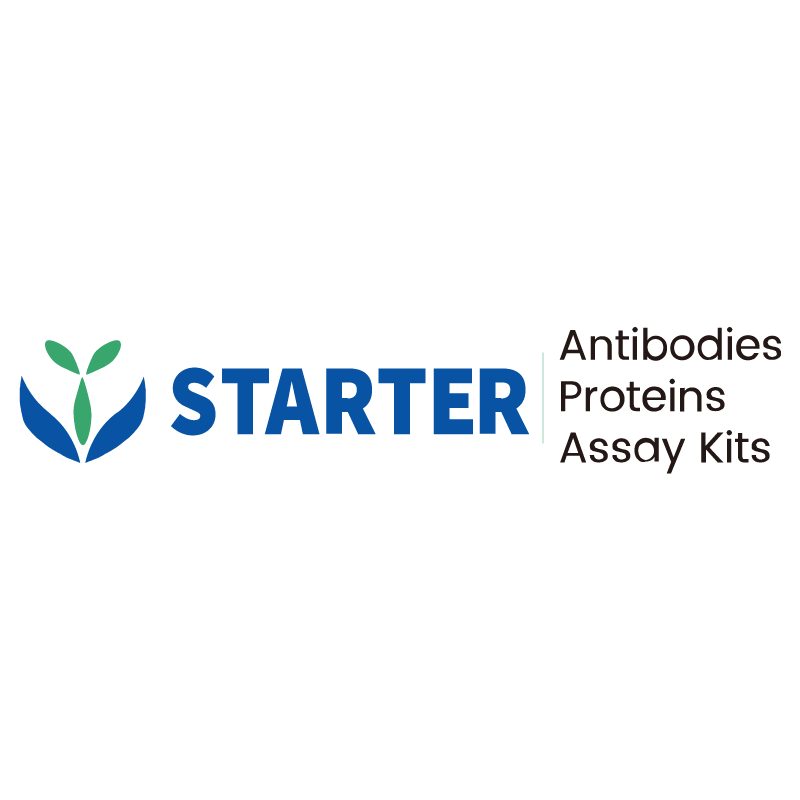WB result of RUVBL1 Recombinant Rabbit mAb
Primary antibody: RUVBL1 Recombinant Rabbit mAb at 1/1000 dilution
Lane 1: 293T whole cell lysate 20 µg
Lane 2: A431 whole cell lysate 20 µg
Lane 3: SK-MEL-28 whole cell lysate 20 µg
Lane 4: PANC-1 whole cell lysate 20 µg
Lane 5: HeLa whole cell lysate 20 µg
Lane 6: K562 whole cell lysate 20 µg
Secondary antibody: Goat Anti-rabbit IgG, (H+L), HRP conjugated at 1/10000 dilution
Predicted MW: 50 kDa
Observed MW: 50 kDa
Product Details
Product Details
Product Specification
| Host | Rabbit |
| Antigen | RUVBL1 |
| Synonyms | RuvB-like 1; 49 kDa TATA box-binding protein-interacting protein (49 kDa TBP-interacting protein); 54 kDa erythrocyte cytosolic protein (ECP-54); INO80 complex subunit H; Nuclear matrix protein 238 (NMP 238); Pontin 52; TIP49a; TIP60-associated protein 54-alpha (TAP54-alpha); INO80H; NMP238; TIP49 |
| Immunogen | Synthetic Peptide |
| Location | Cytoplasm, Nucleus |
| Accession | Q9Y265 |
| Clone Number | S-1600-38 |
| Antibody Type | Recombinant mAb |
| Isotype | IgG |
| Application | WB, IHC-P, ICC, ICFCM |
| Reactivity | Hu, Ms, Rt |
| Positive Sample | 293T, A431, SK-MEL-28, PANC-1, HeLa, K562, NIH/3T3, C6 |
| Purification | Protein A |
| Concentration | 0.5 mg/ml |
| Conjugation | Unconjugated |
| Physical Appearance | Liquid |
| Storage Buffer | PBS, 40% Glycerol, 0.05% BSA, 0.03% Proclin 300 |
| Stability & Storage | 12 months from date of receipt / reconstitution, -20 °C as supplied |
Dilution
| application | dilution | species |
| WB | 1:1000 | Hu, Ms, Rt |
| IHC-P | 1:500 | Hu, Ms, Rt |
| ICC | 1:500 | Hu |
| ICFCM | 1:500 | Hu |
Background
RUVBL1, also known as TIP49 or Pontin, is a protein that belongs to the AAA+ ATPase family. It forms a complex with RUVBL2, collectively known as RUVBL1/2, and functions as a co-chaperone in various cellular processes. These processes include chromatin remodeling, gene expression regulation, DNA replication, and the assembly and maturation of macromolecular complexes such as RNA polymerases and the mTOR complex. RUVBL1 has been implicated in cancer, with its overexpression associated with poor survival rates in various types of tumors. In non-small cell lung cancer (NSCLC), RUVBL1/2 ATPase activity is required for DNA replication and radioresistance, suggesting that inhibiting this activity could potentially increase the effectiveness of radiation therapy. Recent research has shown that RUVBL1 is involved in the regulation of the non-homologous end joining (NHEJ) pathway, which is a critical DNA repair mechanism. In head and neck squamous cell carcinoma (HNSCC), RUVBL1 is amplified and overexpressed, promoting proliferation and inhibiting the differentiation program. It plays a role in incorporating the histone variant H2AZ into chromatin, thereby regulating the transcription of key genes involved in differentiation, cancer cell proliferation, and invasion. Furthermore, RUVBL1 has been shown to correlate with the expression of molecular chaperones in hepatocellular carcinoma (HCC), and its activity is required for the stress response mediated by HSF1 (heat shock factor 1).
Picture
Picture
Western Blot
WB result of RUVBL1 Recombinant Rabbit mAb
Primary antibody: RUVBL1 Recombinant Rabbit mAb at 1/1000 dilution
Lane 1: NIH/3T3 whole cell lysate 20 µg
Secondary antibody: Goat Anti-rabbit IgG, (H+L), HRP conjugated at 1/10000 dilution
Predicted MW: 50 kDa
Observed MW: 50 kDa
WB result of RUVBL1 Recombinant Rabbit mAb
Primary antibody: RUVBL1 Recombinant Rabbit mAb at 1/1000 dilution
Lane 1: C6 whole cell lysate 20 µg
Secondary antibody: Goat Anti-rabbit IgG, (H+L), HRP conjugated at 1/10000 dilution
Predicted MW: 50 kDa
Observed MW: 50 kDa
FC
Flow cytometric analysis of 4% PFA fixed 90% methanol permeabilized 293T (Human embryonic kidney epithelial cell) labelling RUVBL1 antibody at 1/500 dilution (0.1 μg) / (Red) compared with a Rabbit monoclonal IgG (Black) isotype control and an unlabelled control (cells without incubation with primary antibody and secondary antibody) (Blue). Goat Anti - Rabbit IgG Alexa Fluor® 488 was used as the secondary antibody.
Immunohistochemistry
IHC shows positive staining in paraffin-embedded human testis. Anti-RUVBL1 antibody was used at 1/500 dilution, followed by a HRP Polymer for Mouse & Rabbit IgG (ready to use). Counterstained with hematoxylin. Heat mediated antigen retrieval with Tris/EDTA buffer pH9.0 was performed before commencing with IHC staining protocol.
IHC shows positive staining in paraffin-embedded mouse liver. Anti-RUVBL1 antibody was used at 1/500 dilution, followed by a HRP Polymer for Mouse & Rabbit IgG (ready to use). Counterstained with hematoxylin. Heat mediated antigen retrieval with Tris/EDTA buffer pH9.0 was performed before commencing with IHC staining protocol.
IHC shows positive staining in paraffin-embedded mouse testis. Anti-RUVBL1 antibody was used at 1/500 dilution, followed by a HRP Polymer for Mouse & Rabbit IgG (ready to use). Counterstained with hematoxylin. Heat mediated antigen retrieval with Tris/EDTA buffer pH9.0 was performed before commencing with IHC staining protocol.
IHC shows positive staining in paraffin-embedded rat liver. Anti-RUVBL1 antibody was used at 1/500 dilution, followed by a HRP Polymer for Mouse & Rabbit IgG (ready to use). Counterstained with hematoxylin. Heat mediated antigen retrieval with Tris/EDTA buffer pH9.0 was performed before commencing with IHC staining protocol.
IHC shows positive staining in paraffin-embedded rat testis. Anti-RUVBL1 antibody was used at 1/500 dilution, followed by a HRP Polymer for Mouse & Rabbit IgG (ready to use). Counterstained with hematoxylin. Heat mediated antigen retrieval with Tris/EDTA buffer pH9.0 was performed before commencing with IHC staining protocol.
Immunocytochemistry
ICC shows positive staining in A431 cells. Anti- RUVBL1 antibody was used at 1/500 dilution (Green) and incubated overnight at 4°C. Goat polyclonal Antibody to Rabbit IgG - H&L (Alexa Fluor® 488) was used as secondary antibody at 1/1000 dilution. The cells were fixed with 4% PFA and permeabilized with 0.1% PBS-Triton X-100. Nuclei were counterstained with DAPI (Blue). Counterstain with tubulin (Red).


